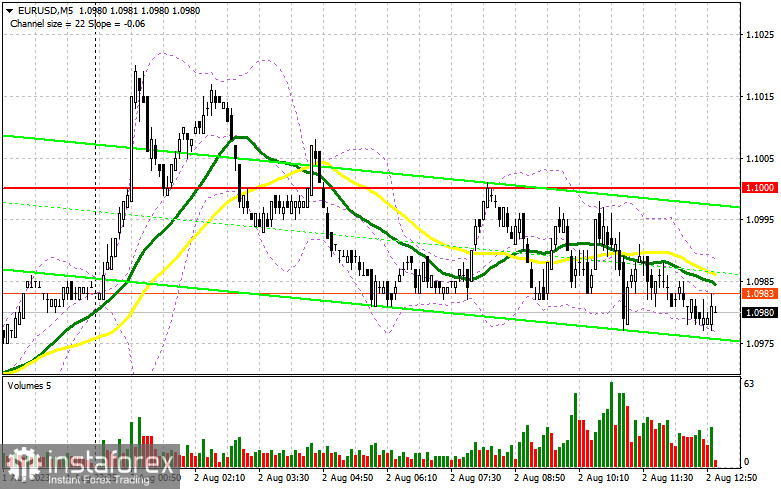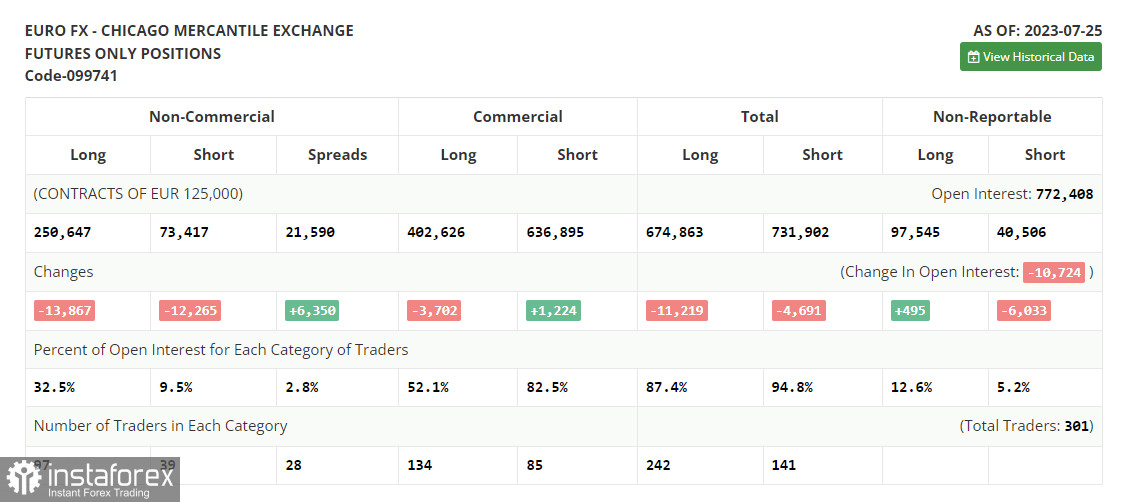In my morning forecast, I drew attention to the 1.1000 level and recommended making trading decisions based on it. Let's look at the 5-minute chart and analyze what happened. However, there was no rise and false breakout around 1.1000. The low market volatility was due to the absence of important fundamental statistics from the Eurozone. The technical picture remained unchanged for the second half of the day.

To open long positions on EUR/USD, the following conditions are required:
During the US session, we expect data from ADP on changes in non-farm employment in the US, which may weaken the US dollar's positions as a sharp decrease in the indicator is expected. If the data turns out to be better than economists' forecasts, showing a sustainable increase in private sector jobs, pressure on EUR/USD will increase, leading to increased volatility and a larger sell-off. In such a case, I prefer to act on opening long positions only after a false breakout from the weekly low at 1.0955. A formation of a false breakout there will signal a buying opportunity, allowing the pair to rise and reach the resistance level at 1.1000, which has yet to be broken above. Moving averages, favoring sellers, are also located there. A breakthrough and a reverse test from the top to the bottom of this range will strengthen the demand for the euro, giving a chance for a breakout of 1.1043. The ultimate target remains around 1.1095, indicating a new upward trend. I will take profits there.
In the case of a decline in EUR/USD and the absence of buyers at 1.0955 during the US session, bears will become more active in building a downward trend. Therefore, only a formation of a false breakout around the next support at 1.0911, as described earlier, will give a signal for buying the euro. I will open long positions on a rebound from the minimum at 1.0871 with a target of a 30-35 point upward correction within the day.
To open short positions on EUR/USD, the following conditions are required:
Sellers reacted to the Asian rise of the pair that occurred after the downgrade of the US credit rating, but they failed to build a larger downward movement. The focus is now on the second half of the day and the US labor market report. In case of the pair's rise, bears can expect resistance at 1.1000, as protecting this level remains a priority. An unsuccessful consolidation there will signal a selling opportunity capable of pushing EUR/USD towards 1.0955 – a new support formed at the end of yesterday's trading. A lot depends on this level, as the pair's return below it may lead to the stop-losses being hit for many players.

Consolidation below this range and a reverse test from bottom to top will directly lead to 1.0911. The ultimate target will be the minimum at 1.0871, where I will take profits. In case of EUR/USD moving up during the US session and the absence of bears at 1.1000, the situation will return under the control of buyers, preserving the chances of the pair's recovery. In that case, I will postpone short positions until the next resistance at 1.1043. Selling is also possible, but only after an unsuccessful consolidation. I will open short positions on a rebound from the maximum at 1.1095 with a 30-35 point downward correction target.
In the COT report (Commitment of Traders) for July 25th, there was a sharp reduction in both long and short positions. This was an obvious consequence of the scheduled meetings of the Federal Reserve and the European Central Bank, the results of which still need to be reflected in these reports. The decisions made by the regulators regarding monetary policy coincided with economists' expectations, maintaining the market balance, which was later disrupted by macroeconomic statistics from the US, indicating the strength of the American economy in the second quarter. However, despite the downward correction, the optimal medium-term strategy in the current conditions remains buying the euro on declines. The COT report indicates that long non-commercial positions decreased by 13,867 to 250,647, while short non-commercial positions decreased by 12,265 to 73,417. As a result, the spread between long and short positions increased by 6,350, favoring euro buyers. The closing price decreased to 1.1075 from 1.1300 a week earlier.

Indicator signals:
Moving averages.
Trading around the 30-day and 50-day moving averages indicates market uncertainty.
Note: The author considers the period and prices of the moving averages on the hourly chart (H1), which differs from the general definition of classic daily moving averages on the daily chart (D1).
Bollinger Bands:
In the case of an uptrend, the upper boundary of the indicator around 1.1020 will act as resistance.
Description of indicators:
• Moving Average (determines the current trend by smoothing volatility and noise). Period 50. Marked in yellow on the chart.
• Moving Average (determines the current trend by smoothing volatility and noise). Period 30. Marked in green on the chart.
• MACD Indicator (Moving Average Convergence/Divergence) - Fast EMA period 12, Slow EMA period 26, SMA period 9.
• Bollinger Bands - Period 20.
• Non-commercial traders - speculators, such as individual traders, hedge funds, and large institutions, using the futures market for speculative purposes and subject to specific requirements.
• Long non-commercial positions represent the total long open position of non-commercial traders.
• Short non-commercial positions represent the total short open position of non-commercial traders.
• The total non-commercial net position is the difference between non-commercial traders' short and long positions.
 English
English 
 Русский
Русский Bahasa Indonesia
Bahasa Indonesia Bahasa Malay
Bahasa Malay ไทย
ไทย Español
Español Deutsch
Deutsch Български
Български Français
Français Tiếng Việt
Tiếng Việt 中文
中文 বাংলা
বাংলা हिन्दी
हिन्दी Čeština
Čeština Українська
Українська Română
Română

